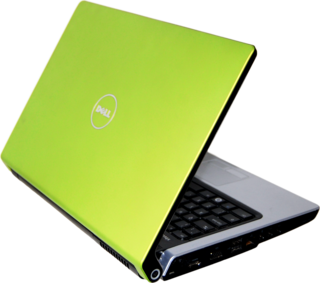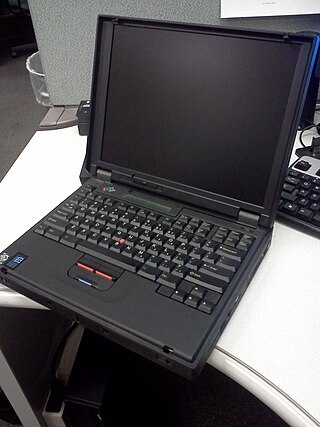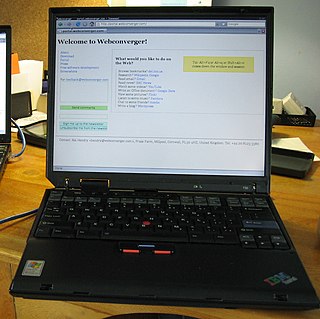
ThinkPad is a line of business-oriented laptop computers and tablets, the early models of which were designed, developed and marketed by International Business Machines (IBM) starting in 1992. IBM sold its PC business, including laptops to Lenovo in 2005, and since 2007, all new ThinkPad models have been branded Lenovo instead. The Chinese manufacturer further developed the line, and is still selling new models in 2024.

Dell XPS is a line of consumer-oriented laptop and desktop computers manufactured by Dell since 1993.

The Panasonic Toughbook is a line of rugged computers produced and marketed by Panasonic. The first model, the CF-25, was introduced in 1996. The Toughbook brand mainly competes with other lines of rugged computers, such as Dell's Rugged Extreme.

The Compaq Presario 1200 was a line of notebook computers produced between 1998 and 2000 by Compaq as part of Compaq Presario line.

The Personal Computer Series, or PC Series, was IBM's follow-up to the Personal System/2 and PS/ValuePoint. Announced in October 1994 and withdrawn in October 2000, it was replaced by the IBM NetVista, apart from the Pentium Pro-based PC360 and PC365, which were replaced by the IBM IntelliStation.

Dell Vostro is a line of business-oriented laptop and desktop computers manufactured by Dell aimed at small to medium range businesses. From 2013–2015, the line was temporarily discontinued on some Dell websites but continued to be offered in other markets, such as Malaysia and India.

Dell Studio is a range of laptops and desktops targeted at the mainstream consumer market, produced by Dell. The computers sit above Dell's Inspiron and below the XPS consumer lines in terms of price and specifications. They differ from Dell's lower-end Inspiron models by offering slot-loading optical drives, media keys, more cover design options, faster processor options, HDMI and eSATA ports, LED-backlit screens, and backlit keyboards.

IBM ThinkPad 310 was a notebook computer series introduced in 1997 by the IBM corporation into the market as part of their ThinkPad laptop series. It was succeeded by the ThinkPad 380 series.

IBM ThinkPad 760 was a notebook computer introduced in 1995 by the IBM corporation into the market as part of the ThinkPad 700-series. It was succeeded in 1998 by the ThinkPad 770 series.

IBM ThinkPad 770 was a laptop designed and manufactured by IBM targeted for the business, enterprise and professional user. It was the last lineup in the ThinkPad 700-series, succeeding the 760 as the high-end laptop of the ThinkPad lineup. The line was produced from October 1997 to May 2000, and eventually replaced by the ThinkPad models A20m and A20p.

The Sony Vaio 505 series was a line of ultraportable notebook computers from Sony's VAIO brand. The introduction date in the United States was July 24, 1998.
The HP Pavilion dv1000 was a model series of laptops manufactured by Hewlett-Packard Company that featured 16:10 14.1" diagonal displays.

The ThinkPad T series is a line of laptop computers. Originally developed by IBM, and introduced in 2000, the brand was sold along with the rest of IBM's business computer division to Chinese technology company Lenovo in 2005, who have continued to produce and market succeeding models.

The ThinkPad X series is a line of laptop computers and convertible tablets produced by Lenovo with less power than its other counterparts. It was initially produced by IBM until 2005.

The IBM ThinkPad 600 series was a series of notebook computers introduced in 1998 by IBM as an lighter and slimmer alternative to the 770 series. Three models were produced, the 600, 600E, and 600X; the series was succeeded in 2000 by the ThinkPad T20 series.

The IBM ThinkPad T20 series was a series of notebook computers introduced in May 2000 by IBM as the successor of the 770 series and the first model of the T-series which exists today under Lenovo ownership. Four models were produced, the T20, T21, T22, and T23; the series was succeeded in May 2002 by the ThinkPad T30, but was produced until July 2003.

The IBM ThinkPad 365 is a notebook computer series developed by IBM and manufactured by ASE Group. It was released in North America in November 1995, and was the successor of the ThinkPad 360 series. The series had 8 models that were released before being discontinued, and was succeeded in 1997 by the ThinkPad 380 series.

The IBM ThinkPad 360 series was a notebook computer series introduced in 1994 by IBM as part of their ThinkPad laptop series. It was succeeded in late 1995 by the IBM ThinkPad 365 series.

The ThinkPad 755 is a series of high-end notebook-sized laptops released by IBM from 1994 to 1996. All models in the line feature either the i486 processor or the original Pentium processor by Intel, clocked between 50 and 100 MHz. The ThinkPad 755CD, introduced in October 1994, was the first notebook on the market with an internal full-sized CD-ROM drive. The ThinkPad 755 series was the top-selling laptop for much of 1994, beating out competition from Apple Computer and Compaq. IBM replaced it with the ThinkPad 760 series in January 1996.

The IBM ThinkPad T30 is a laptop computer manufactured by IBM.



















